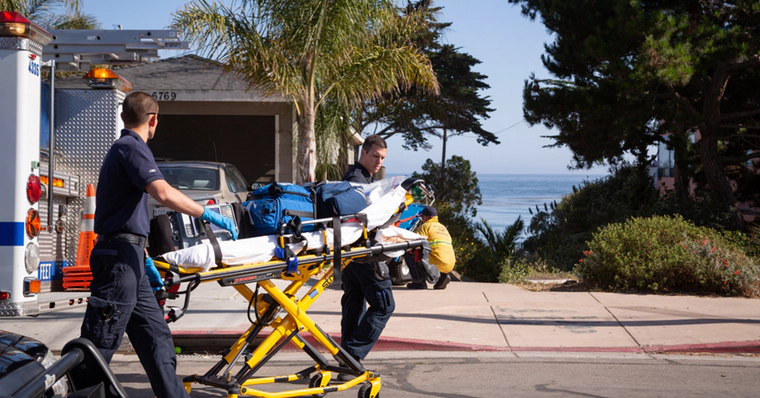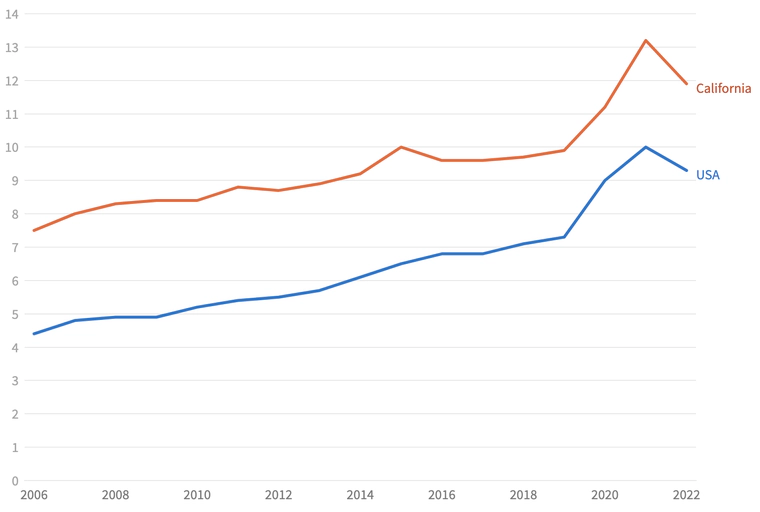Alcoholic Liver Disease Deaths are on the Rise
This article ties in recent data from a study on alcoholic liver disease with new data from the NIAAA on alcohol consumption in the U.S., showing how America’s increase in alcohol consumption directly affects lifespan and quality of life for millions of people.

A new report has shown that even as public health efforts have sought to inform the American people of the harm of drinking, alcohol-related liver disease deaths soared during the pandemic and have remained high since.
Alcoholic Liver Disease and Its Harm
More than alcohol-related cardiac health issues, drunk driving accidents, falls, drownings, and other injuries, alcohol-related liver diseases are the single leading cause of alcohol-related deaths nationwide, and they are rising quickly. For example, in California, the death rate from alcohol-related liver disease during 2020, 2021, and 2022 was 25% higher than in 2017, 2018, and 2019. The death rate in California reached 13 deaths per 100,000 in 2021, up from 7.3 per 100,000 in 2019 and 4.4 per 100,000 in 2006. And while the death rate fell to 10 per 100,000 in 2022, it’s still much higher than pre-pandemic levels.
Those are the preliminary findings of KFF Health News analysis in California, which showed that more Californians are now dying from alcohol-related liver disease than car accidents or breast cancer.1

Image Courtesy of wonder.cdc.gov
Why Did Alcohol Consumption Soar During the Pandemic?
The COVID-19 pandemic was an unprecedented health event in the U.S., and California-based researchers highlighted isolation, depression, anxiety, and other factors as being critical predictors for spikes in alcohol consumption throughout 2020, 2021, and 2022. The data also showed that while overall alcohol consumption by volume increased, the consumption of spirits increased by the widest margin.
Between 2020 and 2022, 14,209 Californians died from alcohol-related liver diseases, with the height of the deaths occurring in 2021 when 13.2 out of every 100,000 Californians were dying from the health crisis. What is of particular concern to researchers is that, while such deaths receded slightly in 2022, they still have not returned to pre-pandemic levels, even as the conditions that helped create the epidemic of alcohol consumption (isolation and the stress of the pandemic) are no longer present.

Unfortunately, it would seem thousands of Californians – and likely thousands more Americans in other states – became addicted to alcohol during the pandemic and are still suffering.
Another factor that may explain part of the spike in alcohol-related liver disease is the connection between alcohol consumption, inactivity, and poor diet. According to one of the researchers who predicted the spike in alcohol-related liver diseases, the disease is much more likely to affect people with metabolic syndrome, a condition often characterized by excess body fat around the waist. Metabolic syndrome—often caused by poor diet and an inactive lifestyle—has risen nationwide, particularly spiking during the pandemic when millions of Americans adopted a far more sedentary and inactive lifestyle.
Brian Lee, a hepatologist and liver transplant specialist with Keck School of Medicine of the University of Southern California, outlined the factors that put people at risk. “Having metabolic syndrome, which is associated with obesity, high blood pressure, and diabetes, more than doubles your risk of having advanced liver disease at the same level of drinking,” Lee said. Further, Lee pointed out that the crisis particularly impacts Californians between 55 and 64. This group makes up just a quarter of the state’s adults but comprises more than half the state’s annual deaths from alcohol-related liver disease.2
But that’s only part of the story. Alcohol-related liver disease is also affecting young Americans ages 25 to 44. “People are drinking at earlier levels,” Lee said. “People are developing obesity at younger ages.” To Lee’s point, about 2,650 Californians in the 25 to 44 age group died of the disease during the last three years, compared with 1,270 deaths from 2010 through 2012.3

What is Alcohol-Related Liver Disease?
Alcohol-related liver disease (also called alcoholic liver disease) is usually caused by years of excessive drinking, but new data suggests it can occur after a short period of heavy alcohol use, as evidenced by the sharp uptick in such diseases during and shortly following the pandemic. Unfortunately, there are no symptoms until late in the disease when weakness, jaundice, and confusion manifest.
Alcohol-related liver disease refers to damage to the liver caused by excess or prolonged alcohol intake. Though the disease does not cause noticeable symptoms until the liver has been severely damaged, side effects include:
- Feeling ill
- Weight loss
- Loss of appetite
- Confusion, drowsiness, stupor
- Swelling in the ankles and the abdomen
- Jaundice (yellowing of the whites of the eyes)
- Vomiting up blood or passing blood in one’s stool
The liver is the body’s first line of defense against toxins entering the bloodstream. The liver also aids in food digestion, in regulating blood sugar and cholesterol, and in fighting infection and disease. Though the liver is quite resilient, each time the liver filters alcohol, the toxins in alcohol cause some liver cells to die.4
Though the liver can develop new cells, prolonged alcohol consumption over time (or heavy drinking in a short period) can reduce the liver’s ability to regenerate, leading to permanent liver damage. The different forms of alcohol-related liver disease – alcoholic fatty liver disease, alcoholic hepatitis, and liver cirrhosis – are all harmful and dangerous. They can all lead to death if those afflicted with such diseases do not stop drinking.
The Need for Alcohol Addiction Treatment
According to the National Institute on Alcohol Abuse and Alcoholism, about 47.4% of the 100,530 liver disease deaths in the U.S. in 2021 involved alcohol. Further, alcohol-associated liver diseases were the primary cause of almost 1 in 3 liver transplants in the United States from 2010 to 2016, replacing hepatitis C virus infection as the leading cause of liver transplantation due to chronic liver disease. Also according to the NIAAA, at least 60 million Americans over the age of 12 (21.5% of that population) drink alcohol to excess at least once per month.5
Without a doubt, Americans are experiencing more harm from alcohol because they are drinking alcohol more often, and they are consuming greater volumes of alcohol when they drink. An increase in frequency and volume of consumption puts drinkers at extremely high risk for addiction, i.e., when one’s alcohol consumption becomes compulsory and involuntary.
If you know someone who drinks alcohol and cannot stop on their own, please help them find and enter a qualified alcohol addiction treatment center. Please do not wait until it is too late.
Sources Cited:
-
KFF. “Excessive Drinking During the Pandemic Increased Alcoholic Liver Disease Death Rates.” KFF Health News, 2023. kffhealthnews.org ↩︎
-
USNews. “Alcoholic Liver Disease Death Rates Surged During the Pandemic.” U.S. News, 2023. usnews.com ↩︎
-
AASLD. “Effect of increased alcohol consumption during COVID-19 pandemic on alcohol-associated liver disease: A modeling study.” American Association for the Study of Liver Diseases, 2021. aasldpubs.onlinelibrary.wiley.com ↩︎
-
NHS. “Overview: Alcohol-related liver disease.” National Health Service, 2023. NHS.uk ↩︎
-
NIAAA. “Alcohol’s Effects on Health.” National Institute on Alcohol Abuse and Alcoholism, 2023. niaaa.nih.gov ↩︎







 ®
®